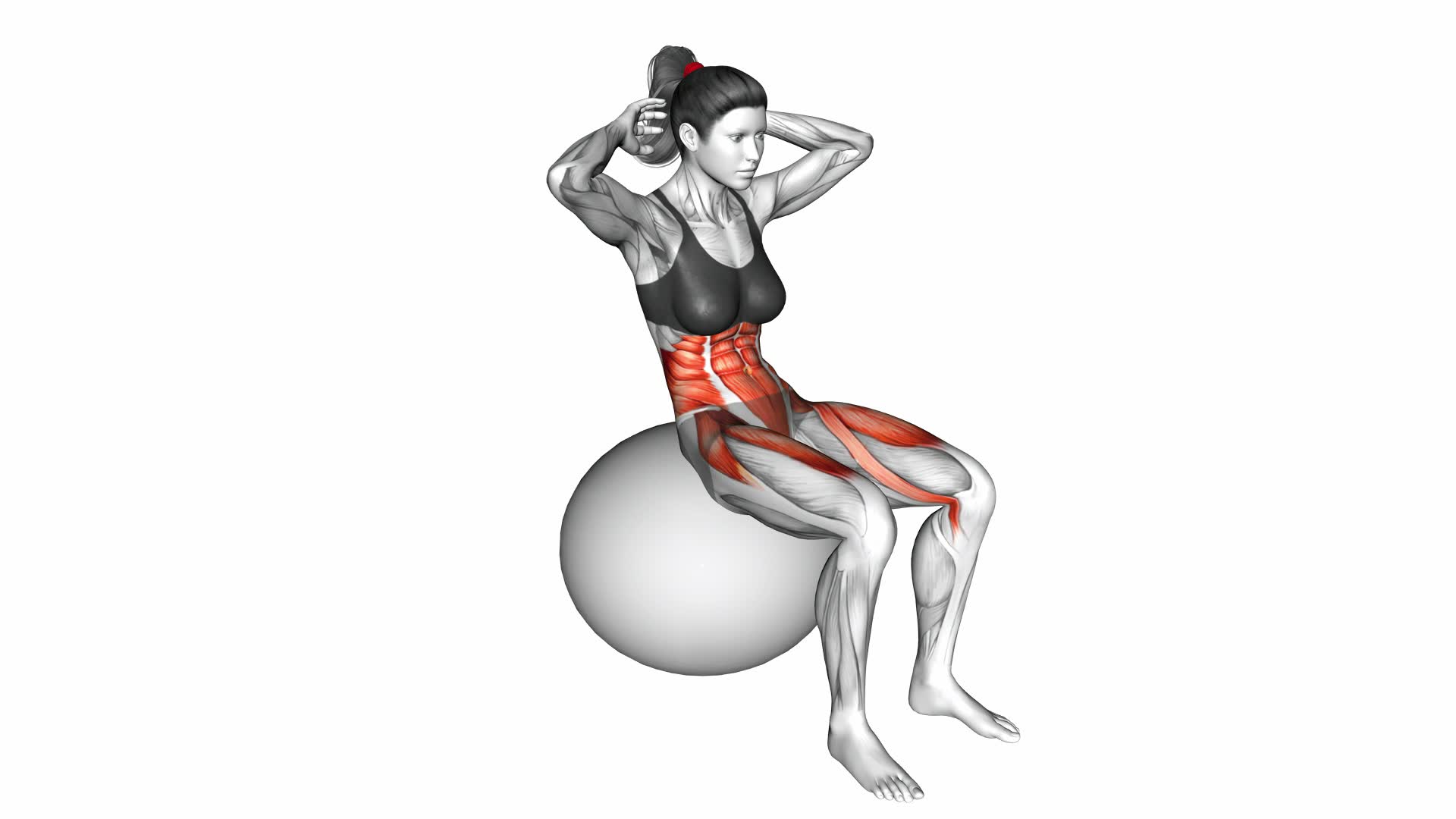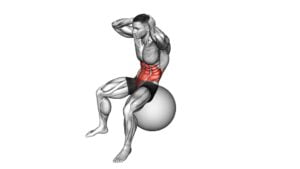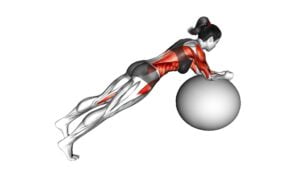Ball Sit-up (on stability ball) – Video Exercise Guide & Tips

Are you looking for a way to spice up your routine sit-ups? Ball sit-ups on a stability ball are an effective alternative that offers increased core engagement and improved balance.
Watch This Exercise Video
In this blog, we’ll share guidelines and video tips on how to correctly perform ball sit-ups, along with suggestions for gradual exercise progressions. Let’s dive in – it’s time to take your core training to the next level!
Key Takeaways
- Ball sit – ups on a stability ball engage core muscles, improve balance and stability, and increase range of motion.
- To perform ball sit – ups correctly, position yourself with your lower back resting on the ball and feet flat on the ground. Engage your core muscles as you lift your upper body off the ball while exhaling. Lower yourself back down to starting position with control.
- Alternatives to traditional sit-ups include Russian twists, planks, and bicycle crunches. These exercises target the core muscles effectively without relying solely on traditional sit-ups.
- Equipment needed for ball sit – ups includes a stability ball, medicine ball, resistance bands, and a foam roller. These tools add variety and challenge to your workout routine for better results.
Benefits of Ball Sit-ups on a Stability Ball
Ball sit-ups on a stability ball engage core muscles, improve balance and stability, and increase range of motion.
Engages core muscles
Performing ball sit-ups effectively engages your core muscles. This exercise targets not only the abdominal muscles but also the obliques and lower back, making it a comprehensive workout for your entire core.
The stability ball adds an element of balance to the movement, forcing you to utilize more muscle groups in maintaining your position on the unstable surface. As a result, this promotes muscle growth and strength.
Improves balance and stability
Doing ball sit-ups on a stability ball is an excellent way to improve your balance and stability. When you perform sit-ups on the unstable surface of the ball, it requires your core muscles to work harder to maintain your balance.
This helps strengthen not only your abs but also the muscles in your back and hips that assist with stability. By regularly incorporating stability ball sit-ups into your workout routine, you can enhance your overall balance and stability, making everyday activities easier and reducing the risk of falls or injuries.
Increases range of motion
Performing ball sit-ups on a stability ball can greatly increase your range of motion. As you engage your core muscles and lift yourself up, the instability of the ball forces you to use more muscles than traditional floor sit-ups.
This added challenge allows you to stretch your abdominal muscles further, leading to an improved range of motion in your upper body. By consistently incorporating this exercise into your routine, you’ll not only strengthen your core but also enhance your flexibility and overall mobility.
How to Do a Ball Sit-up
To perform a Ball Sit-up on a stability ball, start by positioning yourself with your lower back resting on the ball and feet flat on the ground. Place your hands behind your head or crossed over your chest.
Engage your core muscles and slowly lift your upper body off the ball while exhaling, making sure to keep your neck aligned with your spine. Inhale as you lower yourself back down to the starting position, maintaining control throughout the movement.
Repeat for the desired number of repetitions.
Positioning on the stability ball
To properly position yourself on the stability ball for ball sit-ups, start by sitting on the ball and slowly walk your feet forward until your back is resting comfortably against the ball.
Make sure your feet are shoulder-width apart and firmly planted on the ground. Keep your knees at a 90-degree angle, with your thighs parallel to the floor. Gently engage your core muscles to maintain balance and stability throughout the exercise.
This positioning allows for proper alignment of the spine and ensures that you can perform sit-ups effectively while engaging your abdominal muscles.
Proper form and technique
To perform ball sit-ups on a stability ball effectively, it is important to maintain proper form and technique. Start by positioning yourself on the stability ball with your lower back resting comfortably against the center of the ball.
Bend your knees at a 90-degree angle and keep your feet flat on the ground for stability. Place both hands behind your head or crossed over your chest, engaging your core muscles throughout the movement.
As you crunch up, exhale and lift your upper body off the ball while keeping your lower back pressed against it. Avoid pulling on your neck or using momentum to swing upwards. Slowly lower back down to starting position while inhaling, maintaining control throughout the exercise.
Remember to keep a neutral spine alignment during each repetition for optimal results.
Furthermore, focus on incorporating these key elements into every repetition: squeeze your abs as you reach the top of each crunch; avoid yanking or straining through any part of the movement; ensure that all movements are controlled and deliberate; listen to what feels natural for you regarding range of motion without pushing past discomfort or pain levels – particularly if you have any pre-existing medical conditions such as herniated discs in which case check with a healthcare professional prior performing this exercise.
Alternatives to traditional sit-ups
There are several alternatives to traditional sit-ups that can still effectively target your core muscles. One option is the Russian twist, where you sit on the ground with your knees bent and feet lifted off the floor.
Hold a medicine ball or weight in front of you and twist your torso from side to side, engaging your oblique muscles. Another alternative is the plank exercise, which involves holding a push-up position while keeping your body straight and supported by your forearms and toes.
This exercise engages multiple muscle groups, including your abs, back, and shoulders. Lastly, you can try bicycle crunches, where you lie on your back with knees bent and hands behind your head.
Equipment Needed for Ball Sit-ups
You’ll need a stability ball, medicine ball, resistance bands, and a foam roller for effective ball sit-ups. Don’t miss out on these essential pieces of equipment to maximize your workout!
Stability ball
Using a stability ball for sit-ups adds an extra challenge to the exercise. The unstable surface engages your core muscles even more, helping to strengthen and tone your abs. In addition, sitting on the ball during sit-ups improves balance and stability, working other muscles as well.
It also allows for a greater range of motion compared to traditional floor sit-ups, giving you a more effective workout for your abdominal muscles. So grab a stability ball and start incorporating it into your sit-up routine for a stronger core!
Medicine ball
To add an extra challenge to your ball sit-ups, you can incorporate a medicine ball. Holding the medicine ball while performing the exercise increases the resistance and adds an element of upper body strength training.
As you perform the sit-up, engage your core muscles and bring the medicine ball up towards your knees or chest, depending on your fitness level. This variation not only targets your abs but also works your arms and shoulders, making it a full-body workout.
Start with a lighter weight medicine ball and gradually increase as you get stronger.
Incorporating a medicine ball into your stability ball sit-ups is a great way to take your core workout to the next level. It helps to build strength in multiple muscle groups simultaneously and adds variety to keep you motivated.
Resistance bands
Resistance bands are a versatile and effective tool for incorporating additional resistance into your stability ball sit-ups. By attaching one end of the band to a sturdy anchor point and holding onto the other end, you can increase the intensity of your sit-up movement.
This added resistance challenges your core muscles even more, helping to strengthen and tone them. Resistance bands also provide a different type of resistance compared to weights or bodyweight exercises, which can help add variety to your workout routine.
Incorporating resistance bands into your stability ball sit-ups can take this exercise to the next level and help you achieve even greater results.
Foam roller
Using a foam roller during ball sit-ups can provide additional support and stability to your workout routine. By placing the foam roller under your lower back, you create a slight incline that challenges your core muscles even more.
This added instability engages your abdominal muscles further as they work to stabilize your body on the rolling surface of the foam roller. Foam rollers also help improve balance and coordination, making this exercise more challenging and effective for building core strength.
Tips for Performing Ball Sit-ups
Focus on maintaining proper breathing technique, gradually increase the difficulty of the exercise over time, and always utilize proper form to maximize the effectiveness of your ball sit-ups.
Proper breathing technique
To optimize your ball sit-up performance, it’s important to focus on proper breathing technique. Taking slow and controlled breaths can help you engage your core muscles effectively during the exercise.
As you lower yourself down onto the stability ball, inhale deeply through your nose, expanding your diaphragm and filling your lungs with air. Exhale slowly through pursed lips as you come up into a sitting position, actively contracting your abdominal muscles.
This rhythmic breathing pattern allows for better oxygenation of the body and supports the engagement of your core throughout each repetition. By maintaining proper breathing technique, you can enhance the effectiveness of your ball sit-ups and achieve optimal results in strengthening your core muscles.
Gradually increasing difficulty
To continue challenging yourself and making progress with ball sit-ups on a stability ball, it’s important to gradually increase the difficulty level. You can do this by adding resistance to your workout, such as using a medicine ball or resistance bands.
Another way to increase difficulty is by incorporating balance exercises into your routine, such as performing sit-ups on an unstable surface like a Bosu ball. Additionally, you can try variations of the traditional sit-up, like twisting your torso or lifting one leg off the ground.
By gradually increasing difficulty in these ways, you’ll continue strengthening your core muscles and improving your overall stability and balance.
Utilizing proper form
Utilizing proper form is crucial when performing ball sit-ups on a stability ball. Start by positioning yourself on the stability ball with your lower back supported and feet firmly planted on the ground.
As you perform the sit-up, engage your core muscles and avoid using momentum to lift yourself up. Keep your neck relaxed and maintain a slow and controlled motion throughout the exercise.
This will ensure that you are effectively targeting your abdominal muscles while reducing the risk of injury. So always remember to focus on maintaining proper form for optimal results during your stability ball sit-ups.
Conclusion
Incorporating ball sit-ups on a stability ball into your workout routine can have numerous benefits. Engaging core muscles, improving balance and stability, and increasing range of motion are just a few of the advantages.
Follow the proper form and technique demonstrated in the video guide to maximize results. So grab your stability ball and get ready to take your sit-ups to the next level!
FAQs
1. What are stability ball sit-ups?
Stability ball sit-ups, also known as exercise ball sit-ups or Swiss ball situps, are core strengthening exercises where you perform a traditional sit-up on a large, inflated rubber ball.
2. How do I do a good form of a Sit-up with an exercise Ball?
To maintain good focus on slow movement and proper alignment when performing ab workouts like crunches and sit-ups using an exercise ball.
3. Can I try different variations of the Ball Sit-up?
Yes! You can explore different variations including medicine ball situps or Sit up half balls to add variety to your stability workout routine for abs.
4. Are there any benefits with Stability Ball Sit-Ups over regular floor Sit-Ups?
When doing stability-ball-based ab workouts including crunches or Sit ups versus those done on the floor, it provides more intense core engagement leading to superior results.
5. Where can I find guidance for Stability Ball Ab Workouts?
You may refer to “Ball Sit-Up (on stability ball) – Video Exercise Guide & Tips” for step-by-step instructions and additional tips.
6. If I don’t have a Stability Ball what could be alternatives?
If you don’t have access to Swiss balls, Bosu balls serve as good alternatives for most of these exercises.

Author
Years ago, the spark of my life’s passion ignited in my mind the moment I stepped into the local gym for the first time. The inaugural bead of perspiration, the initial endeavor, the very first surge of endorphins, and a sense of pride that washed over me post-workout marked the beginning of my deep-seated interest in strength sports, fitness, and sports nutrition. This very curiosity blossomed rapidly into a profound fascination, propelling me to earn a Master’s degree in Physical Education from the Academy of Physical Education in Krakow, followed by a Sports Manager diploma from the Jagiellonian University. My journey of growth led me to gain more specialized qualifications, such as being a certified personal trainer with a focus on sports dietetics, a lifeguard, and an instructor for wellness and corrective gymnastics. Theoretical knowledge paired seamlessly with practical experience, reinforcing my belief that the transformation of individuals under my guidance was also a reflection of my personal growth. This belief holds true even today. Each day, I strive to push the boundaries and explore new realms. These realms gently elevate me to greater heights. The unique combination of passion for my field and the continuous quest for growth fuels my drive to break new ground.



